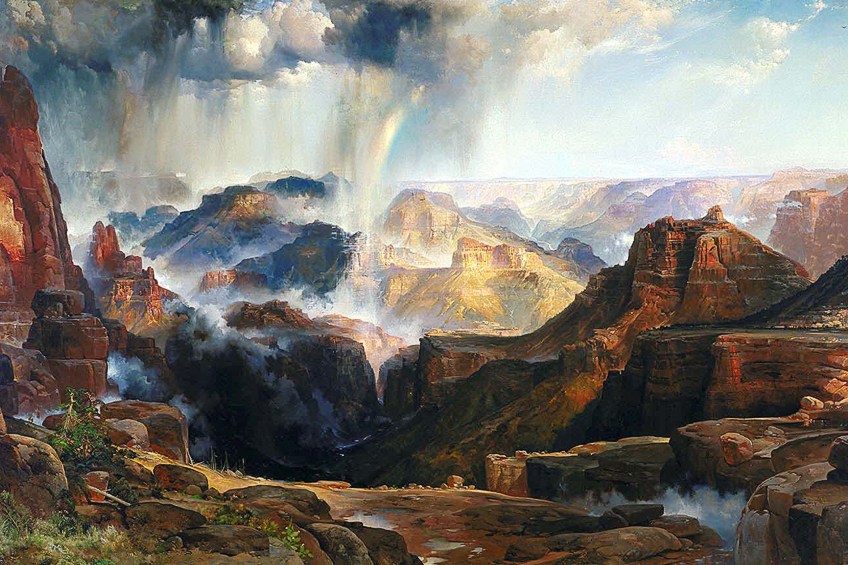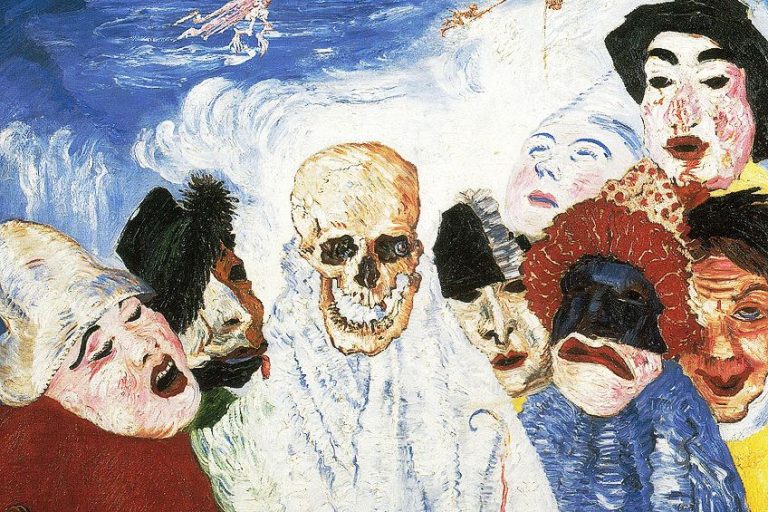Sublime Art – The History of the Sublime Art Movement
What does Sublime mean and how does one define Sublime in art? Sublime art history has roots that extend back to the Italian Renaissance, but it would be the publications of Edmund Burke from the 1750s that would truly spark the Sublime art movement. In this article, we will explore the Sublime artists and Sublime paintings that form the core of this fascinating artistic philosophy.
An Introduction to Sublime Art History
It is during the Italian Renaissance that the initial concept started to arise. The depictions of Christ lifeless and suffering by Andrea Mantegna and Masaccio, as well as Raphael’s sketches and analyses of skeletons, inform us of the certainty of mortality and the unknowable – essential elements of the Sublime. However, it was only in the Romantic era that the Sublime as an artistic notion gained traction throughout Europe.
It all started with Nicolas Boileau’s translation of On The Sublime (1674) by the ancient Greek Longinus. Longinus contended here that the presenter should seek to create emotion and move his audience rather than just convince them. Longinus, who was primarily interested in languages, did speak momentarily about the aesthetic Sublime in both wildlife and man-made artifacts; in his opinion, vast scale and diversity may generate a sense of the Sublime.
“The Sublime is not precisely saying anything which is established or proven, but a wonder, which overpowers one, hits one and causes one to experience,” stated Boileau in his own book on the aesthetic.
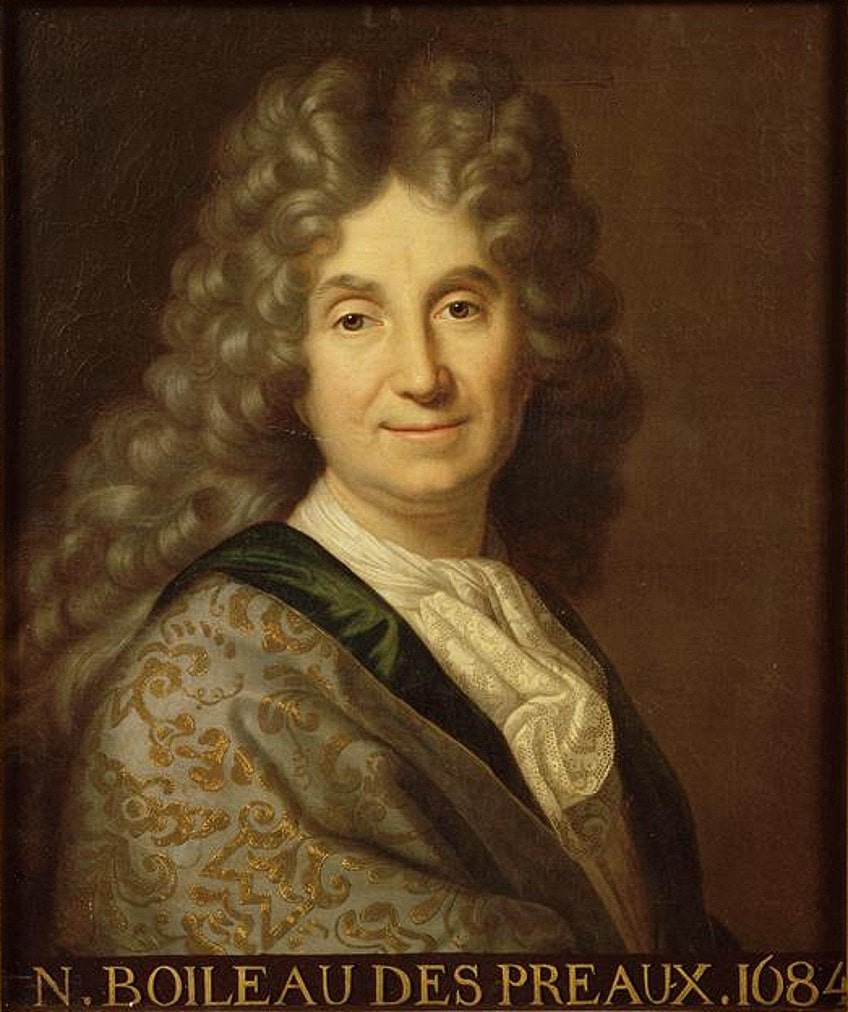
Edmund Burke, a philosopher, published the first significant essay on the Sublime in 1757, in which he attempted to rationally study human impulses. Burke’s thesis, as a logical Rationalist, is based on sensory input, and he goes through many emotions, including the enjoyable, attractive, and majestic. For Burke, joy was not as powerful an emotion as suffering, and he suggested that the Sublime, which he saw as our deepest emotion, was founded in dread, especially the fear caused by the prospect of dying.
“The emotions generated by the vast and majestic in nature, when those causes work most forcefully, is amazement,” Burke wrote, “and amazement is the condition of the psyche in which all its actions are halted, with a sense of dread.”
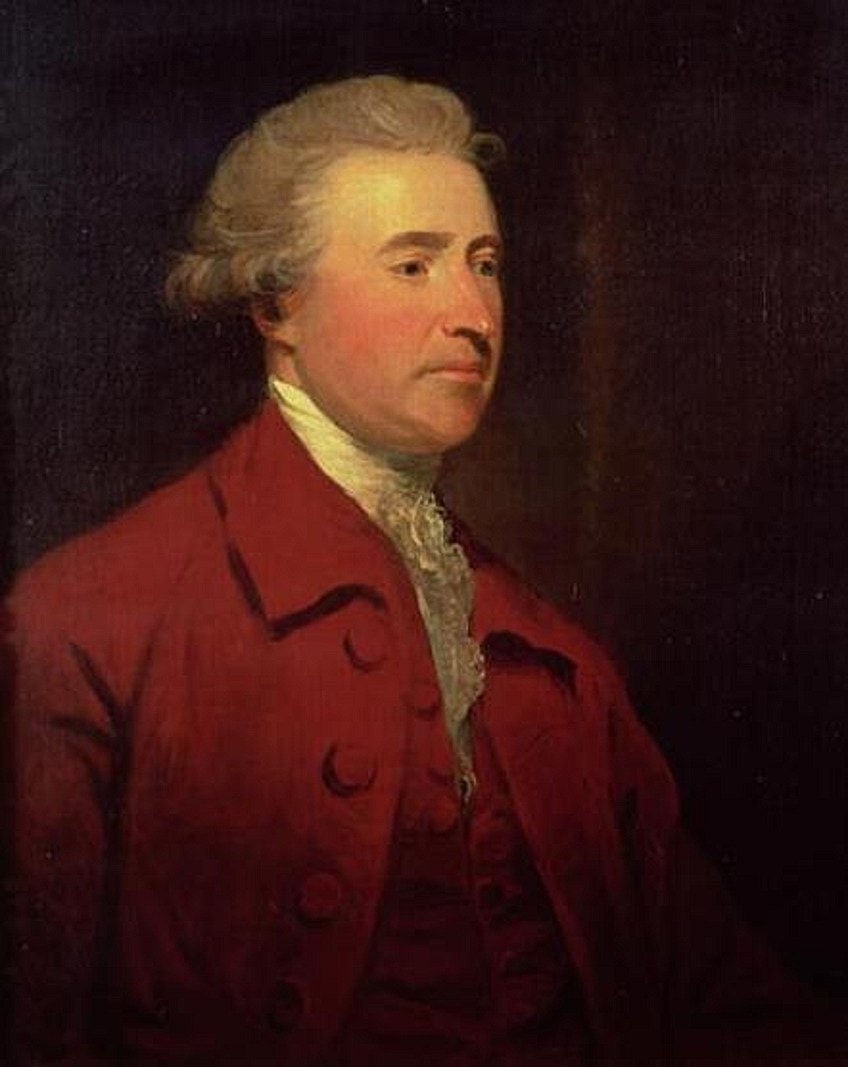
Likewise, Immanuel Kant, a German philosopher, investigated the participant’s reaction to the Sublime, locating the source of the sensation within the human mind. In his Critique of Judgment (1790), he claims two kinds of sublimity: logical sublimity and kinetic sublimity. When one encounters the logical Sublime, one is confronted with the enormity of nature, and one’s mind cannot fully fathom the immensity. However, according to Kant, our capacity of reason steps in and helps us to understand the sensation of eternity before us.
The logical Sublime, therefore, is the impression of reason’s dominance over creation and human imagination.
The kinetic Sublime is similarly a sense of reason’s dominance over nature but through a distinct channel. “The irresistibility of nature’s strength surely makes us, regarded as beings of nature, acknowledge our physiological weakness, but it also exposes a potential for evaluating oneself as separate of the environment and greater than it, through which the soul in our individual continues to remain uneroded even when the life form being must submit to that influence and control,” Kant explained.
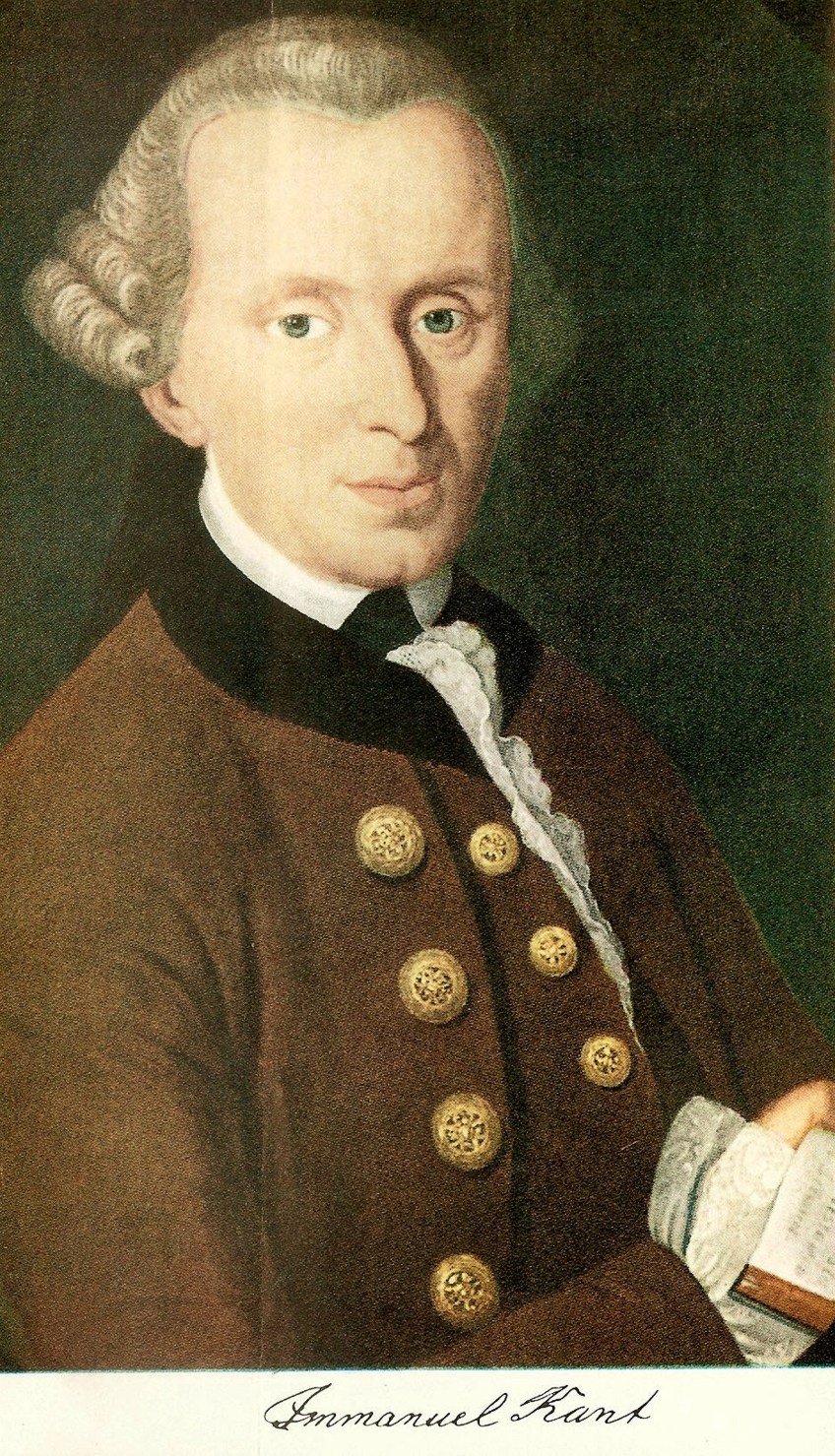
Kant talked of a “restlessness” that one feels in both transcendent experiences; it shakes the soul, as compared to the serene sensation generated by the artwork of beauty. As Kant noted, the Sublime also creates a sense of dissatisfaction, “emerging from the incapacity of vision in the aesthetic assessment of size to rise to its assessment of logic.”
Kant’s concepts of the Sublime were not widely adopted by philosophers, but they had a significant impact on later writings and aesthetic thought.
The Various Movements that Embraced Sublime Landscapes
The Sublime art movement consisted of many smaller schools that could be found in various regions across the globe. Romantic artists embraced Sublime landscapes. As did the French and British and the Americans.
The European Romantics
Kant’s Sublime, which is based on our relationship with creation and our logical reaction to it, was converted as a sort of “art theology” into German Romanticism. It was the beginning of an age in which “the self and the world separated.” Romantic painters frequently used their encounters with the environment or natural occurrences to express the Sublime feeling.
Caspar David Friedrich attempted to portray a sensation of the limitless in his works of fog, mist, and gloom, producing an overpowering impression of nothingness.
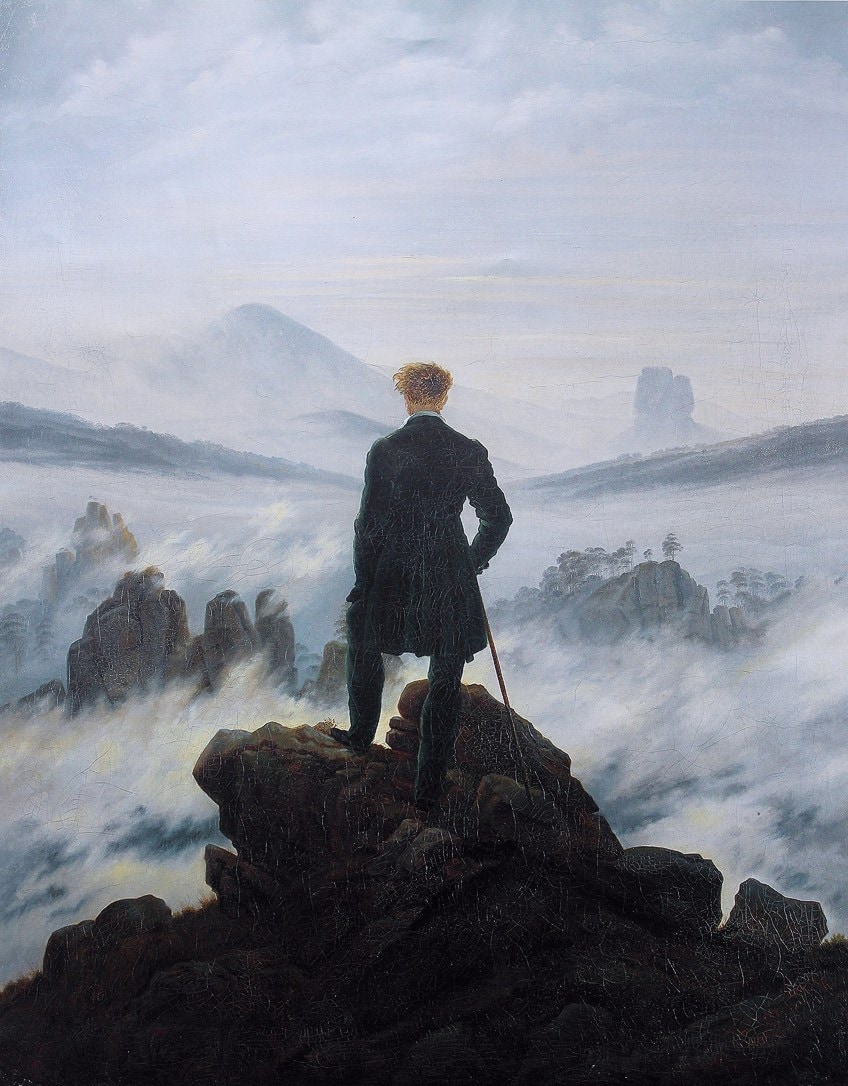
Friedrich’s pictures of solitary individuals against the bold and majestic sky had a wide-ranging effect, and he became a Romantic Painting legend. Around the same period, Théodore Géricault and Eugène Delacroix were exploring the Sublime via terrible and horrible topics like suicides, murders, catastrophes, and guillotined corpses in France. Their artworks were typically huge in size, surrounded the spectator, and featured a clamor of many elements that assaulted the audience’s senses.
The British and French
British landscape artists reacted to the need for excitement and wonder as visitors traveled into wildness such as the Swiss Alps and other wild places to encounter the Sublime. J. M. W. Turner produced strong seascapes, vistas of the Thames river, and fascinating skies that probed the fleetingness of man’s endeavors in the midst of creation, while John Constable portrayed spectacular English landscapes meant to elicit amazement and wonder in the observer.
Indeed, Turner is usually regarded as one of the most effective Romantic painters in expressing Kant and Burke’s vision of the Sublime.

The Barbizon School, which includes Jean-Baptiste-Camille Corot, Jean-François Millet, and Théodore Rousseau, pursued a more intermediate style in France. In landscape painting, these artists attempted to express a sensation of peace, or what was known as the “introspective Sublime.” Sublime landscapes were used as a remedy to the evils of contemporary industry rather than as a strong inquiry into the human experience by painters in this region.
The Hudson River School
Motivated by Turner and his peers, painters like Thomas Cole and Thomas Moran discovered the Sublime in North America’s unspoiled areas, such as the Grand Canyon, and Yosemite Valley, and reproduced it on huge canvases that communicated magnitude and grandeur.
Sublime artists sought to create art that captured the wonder, fear, sheer immensity, and majesty felt at these spectacular locations, which many Americans had never seen firsthand.
Upon journeying the region and rural areas and perceiving the fullness of the American landscape, Frederic Edwin Church, Albert Bierstadt, and subsequently Asher B. Durand investigated concepts of the Sublime during a period of westward development, and their Sublime paintings came to encapsulate what America looked like in the imaginations of many citizens on the East Coast.
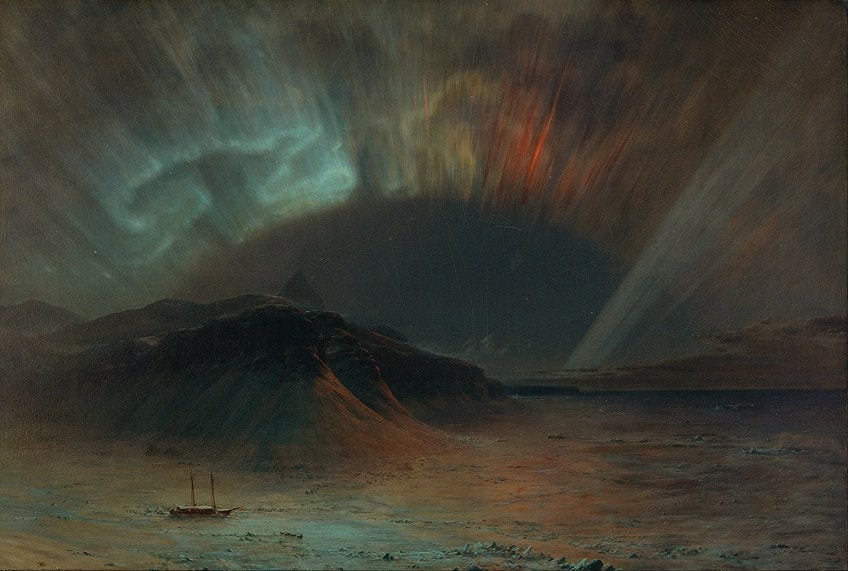
Famous Sublime Artworks
Many artists define Sublime art in very unique ways. Due to the broad definition of what Sublime means, Sublime artists have felt free to express their concepts through everything from traditional oil-based Sublime landscapes to more experimental mediums and materials. Now we will take a look at some important artworks created by the Sublime art movement.
The Raft of the Medusa (1819) by Théodore Géricault
| Date Completed | 1819 |
| Medium | Oil on Canvas |
| Dimensions | 490 cm x 716 cm |
| Currently Housed | Musée du Louvre, Paris |
This violent and terrifying piece is widely regarded as Théodore Géricault’s supreme achievement, and it influenced the course of modern art. The almost 23-by-16-foot canvas portrays the surviving and less lucky inmates of a lifeboat that had been set loose from a crippled navy ship sunk by an inept commander. The people, whether dying or dead, create a terrifying picture as they are tossed around on the choppy West African water. Only 15 men were alive when the boat was finally recovered after 13 days. Another five people perished on the journey, and the incident sparked a modern-day scandal about France’s colonial ambitions.
The painting startled the audience since history artists had never before represented a contemporary event, and its horrific portrayal infuriated them even more.
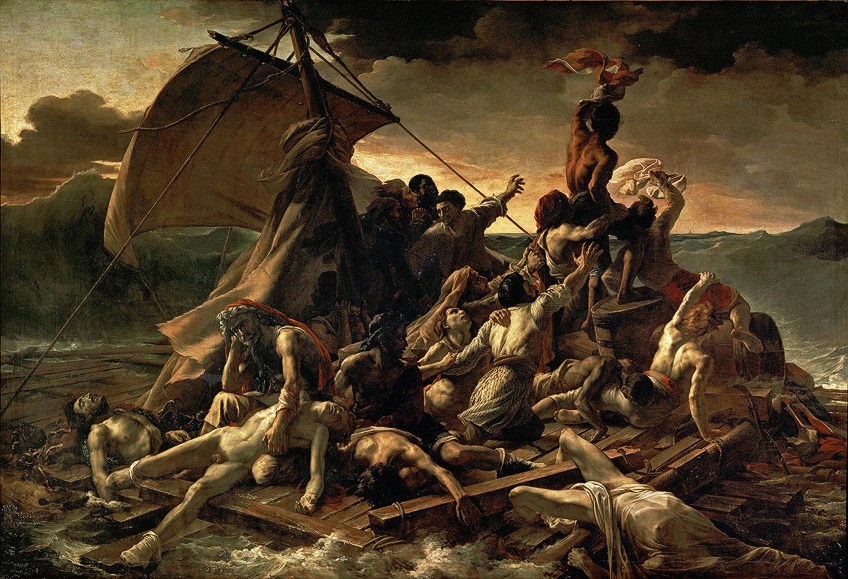
Géricault went to considerable efforts to depict the tragedy of the event authentically, attending mortuaries to examine the skin tone of the deceased and even bringing body pieces home to work from as subjects. The pyramidal design made up of the raft’s sides and the shaky mast, adds to the tragic scene’s intensity. He also employs chiaroscuro to emphasize the macabre complexion of the desiccated corpses and to give tension to a frightening sky.
The artist welcomes the observer onto the dangerous floor of the boat by enabling the raft’s sides to extend past the base of the picture, and by turning the suffering victims’ heads and limbs towards the skyline, the observer is dragged further into the awful scene as they helplessly seek salvation.
The theme of terror and mortality is central to the investigation of the Sublime. “Whatever is suited in any way to stimulate the thoughts of agony and peril, that is to state whatever is in any way truly awful is a basis of the Sublime; that is to say, it is generative of the deepest feeling which the soul is capable of experiencing,” Edmund Burke stated.
Salisbury Cathedral from the Meadows (1831) by John Constable
| Date Completed | 1831 |
| Medium | Oil on Canvas |
| Dimensions | 153 cm x 97 cm |
| Currently Housed | Tate Britain, London |
The sublime becomes obvious in this Sublime painting’s gloomy sky and abundant symbology. Constable, a prominent participant in the Romantic movement, became recognized for his distinctive handling of lighting and use of vivid, realistic hues, yet this enormous canvas has a gloomy and foreboding air to it, raising worries about the Anglican Church’s destiny.
The tower of Salisbury Cathedral penetrates the lightning-cleaved clouds in the middle of the image, yet the opposing lighting in the picture invites a metaphorical interpretation of the structure.
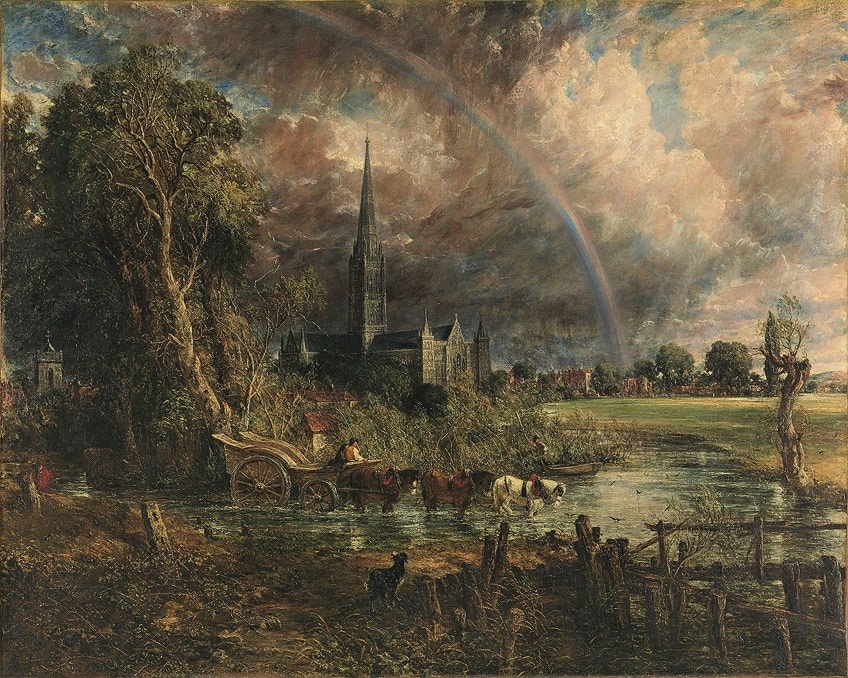
The left bottom triangle split diagonally across the middle depicts a rural setting with a man on horse and cart wading through a brook in mellow brown and orange. A big tree to the left creates a long shadow over the landscape. Notwithstanding the appearance of a rainbow cutting across the composition’s upper triangle, the sky appears gloomy and dismal. Shafts of light clash with rainstorms and the gray sky’s roses are employed to ominous effectiveness.
Many have also linked the conflicting emotions to Constable’s own mental condition following his wife’s demise.
According to art historians, the piece depicts the Sublime. When the artwork was presented at the Royal Academy in 1831, reviewers recognized the variation from the artist’s earlier work but failed to be more specific. The piece was described as “overstated,” “dramatic,” and “abnormal.” However, Constable’s biographer, Charles Robert Leslie, stated that the painter thought the piece communicated “the entire idea of the scope of his work” and that it will “likely be regarded as his finest” image one day.
The Slave Ship (1840) by J.M.W Turner
| Date Completed | 1840 |
| Medium | Oil on Canvas |
| Dimensions | 91 cm x 123 cm |
| Currently Housed | Museum of Fine Arts, Boston |
In his nature paintings and seascapes, J.M.W Turner addressed themes of mortality, dying, and violence. Turner depicts a hazardous ocean in this dramatic and emotive painting, using a palette of flaming yellows and reds. The lower part of the artwork portrays a raging sea engulfing slaves and animals. As the frail, fragile ship sails away, flame-like seas lick at the flaming sky. The horizon appears to tilt, underlining the drowning’s dread and confusion.
A multitude of Sublime notions are at work in this painting: the sun, godlike yet indifferent, in the middle of the canvas invokes the metaphysical, the threat of immersion and death looms, and creation is shown as all-powerful and terrible.
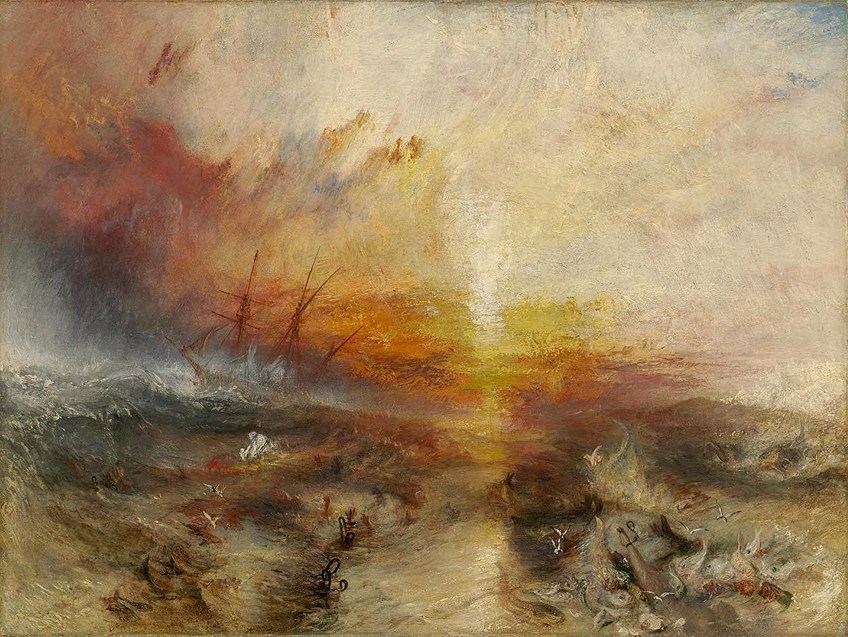
The piece was inspired by a story about a slave ship whose captain threw dying and suffering slaves overboard in order to collect a policy on bodies stranded at sea. Turner was interested in humanity and primordial aggression, and the water offered a strong setting for his magnificent study. Turner’s paintings have been perceived to both enhance and inspire the beholder’s vision. Turner utilized expert brushwork and coloring effects to frighten the spectator.
“If I were compelled to rest Turner’s longevity on any single piece, I should choose this,” remarked critic John Ruskin.
The Chasm of the Colorado (1874) by Thomas Moran
| Date Completed | 1874 |
| Medium | Oil on Canvas |
| Dimensions | 213 cm x 365 cm |
| Currently Housed | Smithsonian American Art Museum, Washington D.C. |
The center of the canvas in this brilliant and dramatic painting opens out to reveal a massive abyss into which the skies and clouds are pulled. The Grand Canyon’s red stonework surrounds the abyss, rising to the left of the painting. The scene’s strength is accentuated with powerful red and black, while the far horizon, portrayed in pastel yellows, blues, and oranges extends the vast landscape’s length. Heavy rain clouds fall to the floor, and a humid mist rises from the soil. The work’s exaltation of grandeur and strength is almost apocalyptic.
The addition of a rainbow completes the image and alludes to the Old Testament’s tremendous end-of-days deluge.
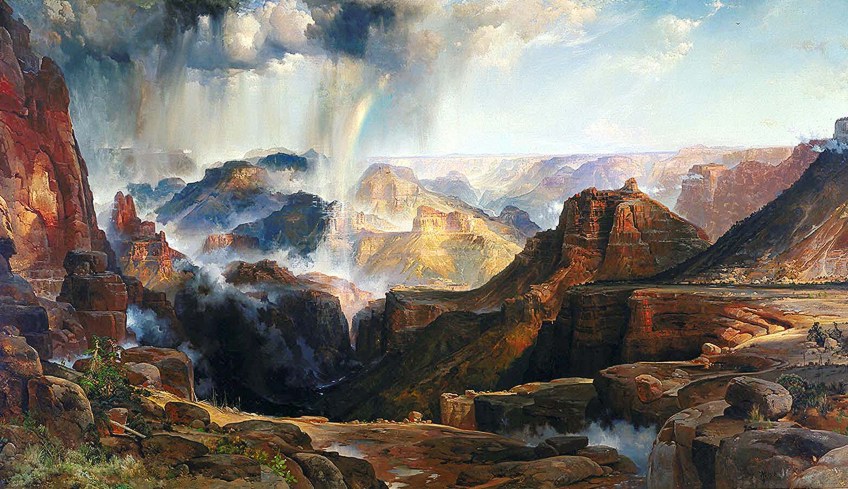
Moran created a painting that speaks to a motionless, immovable, and indifferent history of the planet while simultaneously providing vitality through the dynamic weather-scape from his point of view at Powell’s Plateau, a northern Grand Canyon elevation. This contradiction communicates a sense of insignificance to the observer, who looks on at the completely empty setting. Moran collaborated with adventurer and geologist John Wesley Powell to create the composite, which he painted using drawings, pictures, and arrangements rather than a firsthand sight of the scene.
Moran has depicted the levels, magnitudes, ranges, shapes, hues, and formations with the utmost accuracy.
Black Square (1913) by Kazimir Malevich
| Date Completed | 1913 |
| Medium | Oil on Canvas |
| Dimensions | 79 cm x 79 cm |
| Currently Housed | State Tretyakov Gallery, Moscow |
This piece consists of a black square positioned slightly off-center on a white background. The art world was flipped upside down by this little and seemingly basic canvas. Originally planned as a set design for the last scene of an avant-garde opera, this Sublime painting exemplifies Malevich’s Suprematism, a type of absolute abstraction that was completely non-descriptive.
Malevich claimed to have “liberated art from the encumbrance of the thing” by creating a piece with no hue, shape, meaning, or statement. He believed that experience should be devoid of rational thinking and that pure fact could only be reached via emotion.
Malevich purposefully created a sense of uncertainty in the observer as they searched for significance.
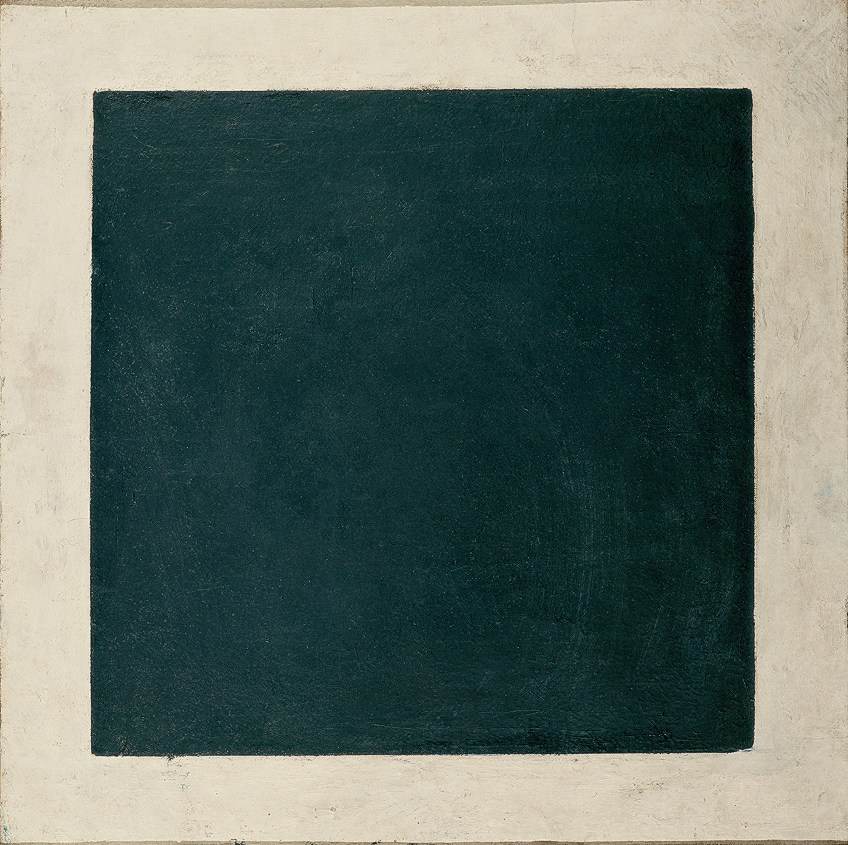
The subconscious would be able to see that the creator was showing the entire universe, and all living within it, in his little, square, simple picture after it had freed itself from its logical cage. the transcendental grandeur; the art transports the spectator beyond the fixed, reasonable boundaries of comprehension.
This painting communicates the sensation of dissatisfaction that emerges from the insufficiency of the mind by favoring flatness over dimension.
The Sublime artist succeeded in communicating the Sublime through purely abstract methods, in our inability to discover a sensible interpretation for Black Square and in the discontentment one feels in that circumstance, an achievement that would elevate successive artists, such as Americans Mark Rothko and Ad Reinhardt, to develop their own variants of it.
Vir Heroicus Sublimis (1951) by Barnett Newman
| Date Completed | 1951 |
| Medium | Oil on Canvas |
| Dimensions | 242 cm x 541 cm |
| Currently Housed | Museum of Modern Art, New York |
This large Sublime painting is done in a rich, vivid, matte red. Five vertical bars, dubbed “zips” interrupt the plain of red over the almost 18 by 8-foot canvas. Moving from left to right, we observe a somewhat brushy orange zip, succeeded by a wider, brilliant white zip. A deep burgundy zip separates the piece again to the side, while another tangerine zip is placed to its right. The Sublime artist added the last zip a year afterward, a broad, tan stripe.
It was Newman’s biggest work during that period, and it was intended to redefine the boundaries between creator and audience, who were urged to scrutinize the canvas closely.

Positioned at the right range, the hues and lines merge and engulf the spectator, and the lighting of the red canvas is projected back on them, transforming their own look – the work visually and, presumably, spiritually transforms the viewer, as per Newman’s intent.
Newman claimed that Europe had struggled to achieve the Sublime in contemporary art, but that painters might achieve the Sublime in America, liberated of the burden of European tradition. He said, “We are liberating ourselves from the obstacles of memory, connection, regret, myth, and legend, Western European artwork has devised. Rather than building temples from Christ, humanity, or ‘existence,’ we are building them from ourselves, from our own sentiments.”
We hope that this article helped you to grasp a deeper understanding of Sublime art history and the Sublime art movement. We have learned about the Sublime artists and their artworks that have brought the concept to the masses, creating Sublime paintings that exude a feeling of grandeur and terrifying awe. These Sublime landscapes opened the doors to loftier expressions of extreme emotions and terrible expressions of nature’s power.
Frequently Asked Questions
What Does Sublime Mean?
Edmund Burke created the Sublime Theory in the mid-18th century, defining Sublime art as “art that alludes to a magnificence beyond all capacity of measurement, assessment, or reproduction.” He described the Sublime as an aesthetic impact that produces the most powerful sensation the intellect is aware of experiencing. “Whatever is in any way awful, is acquainted with dreadful objects, or acts in a manner comparable to horror, is a wellspring of the Sublime,” he wrote.
Where Did Sublime Art Originate?
The very first examples can be found during the Italian Renaissance. The publications of Edmund Burke in the 1750s were a large influence on the art world and led to the Sublime art movement. From there it spread widely to regions such as Europe, Britain, France, and America.
Isabella studied at the University of Cape Town in South Africa and graduated with a Bachelor of Arts majoring in English Literature & Language and Psychology. Throughout her undergraduate years, she took Art History as an additional subject and absolutely loved it. Building on from her art history knowledge that began in high school, art has always been a particular area of fascination for her. From learning about artworks previously unknown to her, or sharpening her existing understanding of specific works, the ability to continue learning within this interesting sphere excites her greatly.
Her focal points of interest in art history encompass profiling specific artists and art movements, as it is these areas where she is able to really dig deep into the rich narrative of the art world. Additionally, she particularly enjoys exploring the different artistic styles of the 20th century, as well as the important impact that female artists have had on the development of art history.
Learn more about Isabella Meyer and the Art in Context Team.
Cite this Article
Isabella, Meyer, “Sublime Art – The History of the Sublime Art Movement.” Art in Context. October 28, 2021. URL: https://artincontext.org/sublime-art/
Meyer, I. (2021, 28 October). Sublime Art – The History of the Sublime Art Movement. Art in Context. https://artincontext.org/sublime-art/
Meyer, Isabella. “Sublime Art – The History of the Sublime Art Movement.” Art in Context, October 28, 2021. https://artincontext.org/sublime-art/.


